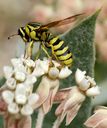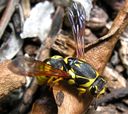Pseudomasaris
Pseudomasaris
Classification
- Phylum: Arthropoda
- Subphylum: Hexapoda
- Class: Insecta
- Order: Hymenoptera
- Superfamily: Vespoidea
- Family: Vespidae
- Subfamily: Masarinae
- Genus: Pseudomasaris
Pronunciation
How to pronounce Pseudomasaris: /ˌsjuːdəʊməˈseɪrɪs/
These audio files are automatically generated. While they are not always 100% accurate, they are a good starting point.
Images


Summary
Pseudomasaris is a genus of pollen wasps belonging to the family Vespidae, predominantly found in arid regions of western North America, known for their unique nesting behavior and oligolectic feeding habits that favor flowering plants like Phacelia.
Physical Characteristics
Most Pseudomasaris species are colored black with yellow or white markings, resembling yellowjackets in some cases.
Identification Tips
Look for black wasps with yellow or white markings; often found in semiarid areas typically nesting on rocks or twigs.
Habitat
Semi-arid and arid regions, often in places with rocks to build nests.
Distribution
Mainly found in western North America, ranging north to approximately 50°N.
Diet
Adults primarily feed on nectar and provision larvae with pollen and nectar from various plants, favoring those in the genera Phacelia and Eriodictyon.
Life Cycle
Most species are likely univoltine, while Pseudomasaris phacelia is multivoltine; individuals emerge from late March to mid-May depending on the region.
Reproduction
Females build mud nests on rocks or twigs and provision offspring with a mixture of pollen and nectar.
Ecosystem Role
Pollen wasps that are integral in the pollination of specific plants, particularly in arid environments.
Similar Taxa
- Yellowjackets
Misconceptions
The coloration of some Pseudomasaris species may lead to confusion with yellowjackets, but they are distinct wasps.
Tags
- Hymenoptera
- Vespidae
- Pollen Wasps
- Western North America
- Arid Regions